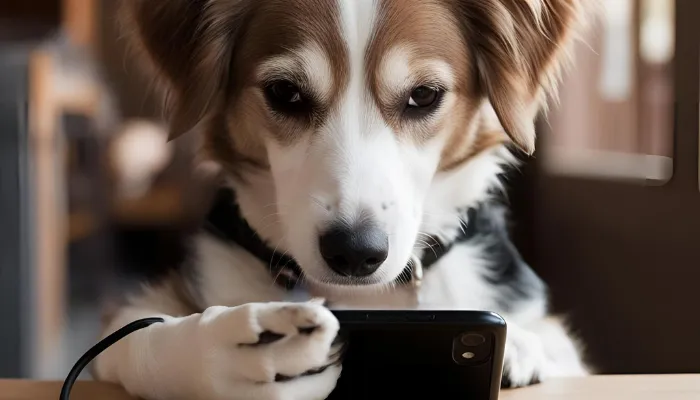What Is Sorry in Dog Language? For dog owners, when a dog’s behavior warrants scolding, some of them do licking the owner’s hand. This is one form of saying apologies. Just like every other animal, dogs have their own language. Sounds, actions, and even body movements and position all have meanings. Recognizing these signs can make the relationship with your dog stronger. From programs like dog translator to just straight looking at their actions, they’re handy in figuring out how your dog dosen’t have to be verbally communicated with. In this, we will try to evaluate how a dog will literally say sorry.

How Do Dogs Say Sorry?
Dogs may not say sorry with words, but their body language reveals their feelings. Submissive gestures like lowered heads, gentle licking, and rolling over show regret. Understanding these signs helps strengthen your bond with them.
As sad as it may sound, dogs don’t utter “sorry”, but instead they regret with their body language which does most of the work for them. Here’s how:
- Lowered Head & Ears Back – A submissive posture indicates guilt.
- Raising Legs Above Eye Contact. Dogs are aware that half raised forelimbs and head positioned at an angle from the from improves the reach of a threat or enemy beyond a threshold is lowering the head.
- Squat Tail & Tuck Leg Ears This position will still reveal tail and ears but hardly visible, submission in form of head waving will defeat the objective so head must be kept down.
- Slow Approach & Gentle Licking – Trying to appease the owner.
- Rolling Over on Their Back – Showing vulnerability as a way to say sorry.
Dogs may not speak, but their body language says it all. Understanding their apology signs strengthens the bond you share.
How Dogs Show Apologies?
Dogs don’t use words, but their body language reveals their apologies. Understanding these signals helps strengthen your bond with them.
Here is a table summarizing the ways dogs express apologies:
| Apology Sign | Meaning |
|---|---|
| Head lowered | Submission, guilt |
| Licking | Trying to mend the bond |
| Wagging tail slowly | A nervous apology |
| Rolling over | Showing vulnerability |
| Avoiding eye contact | Expressing regret |
Dogs have their own way of saying sorry, using body language to show regret. Recognizing what is sorry in dog language helps deepen your connection.
Do Dogs Feel Guilt or Just React to Your Tone?
Dogs respond to tone, actions, and past experiences, not true guilt. Their apology signals reflect learned behavior rather than deep remorse. Understanding what is sorry in dog language helps you interpret their reactions better.
Dogs exhibiting apologetic tendencies may not accurately undergo the guilt phase which is inherently human-centric. To compare it to a dog, they respond to:
- Your Tone Of Voice – The dog would show submissive gestures. If the owner displays anger there is a certain tone adopted by the human when showing anger.
- Your Actions – Body language is a powerful tool in communication which dogs use to modify their behavior as it is exhibited.
- Past Experiences – If they’ve been scolded before, they might repeat their “sorry” gestures.
Dogs may not truly feel guilt, but they react to tone, actions, and past experiences. Their apology signals are a response to human emotions. Understanding what is sorry in dog language helps interpret their behavior better.
Signs Your Dog Is Saying Sorry
We apologise to people for a number of reasons. For dogs to perform these Explanatory behaviors, what should be taken into consideration is if should be taken the amount of explanation.
- Softeness In Whining – A loud expression of sadness.
- Pawing at You – Seeking reassurance and forgiveness.
- Leaning on You – Wanting to rebuild trust.
- Slow, Cautious Movements – Testing if you are still upset.
Dogs express sorry through subtle gestures, from whining softly to leaning for comfort. Their actions reflect a desire to mend the bond. Recognizing what is sorry in dog language strengthens your connection with them.
How to Respond When Your Dog Says Sorry?
Dogs express apologies through subtle gestures, and how you respond matters. Offering calm reassurance, avoiding over-scolding, and using positive reinforcement helps them learn. Strengthening this understanding builds trust and a stronger bond.
Once your dog apologizes, here’s how to respond:
- Acknowledge Their Apology – Offer a calm pet or soothing words.
- Don’t Over Scold -Over scolding can create a confusion.
- Use Treats to Encourage Good Behaviors -In most cases, positive actions will be enabled by treats and good praise.
- Do Not Alter the Cues –Setting out rules for the commandments helps dogs learn in a more efficient manner.
- Change the Good Actions –They need to be shown somewhere like a toy if they have bitten something.
Responding calmly to your dog’s apology signals helps build trust. Positive reinforcement ensures they learn and feel secure.
Can Dogs Learn to Apologize?
Dogs don’t naturally apologize, but they can learn gestures that mimic regret. Teaching submissive actions like offering a paw or responding to cues reinforces boundaries. Understanding what is sorry in dog language helps strengthen communication and trust.
Dogs do not naturally apologize like humans, but they can learn behaviors that mimic an apology:
- Train Them to Offer a Paw – Teaching “shake” can resemble a handshake of apology.
- Use a Cue Word – Saying “be nice” in a gentle voice can reinforce apologetic behavior.
- Encourage Submissive Actions – Rewarding calm behavior helps reinforce apologies.
Dogs may not apologize like humans, but they can learn gestures that mimic regret. Reinforcing submissive actions helps them understand boundaries. Recognizing what is sorry in dog language strengthens communication and trust.
Why Understanding Dog Apologies Matters
Recognizing what is sorry in dog language improves communication and trust. Misinterpreting their actions can lead to unnecessary punishment. Understanding their apology signals strengthens your bond and creates a happier relationship.
Having a threat of some form is free and easy. Here’s where it gets not hard.
- Cuts down the chance of miscommunication existing between your and your pet.
- Reduces unnecessary punishment when they are already remorseful.
- Strengthens the human-dog relationship through clear understanding.
Understanding what is sorry in dog language helps build trust and clear communication. Strengthening this bond ensures a happier relationship for both you and your pet.
Conclusion
What Is Sorry in Dog Language? Every dog has their very own way of telling you they are sorry. Linguistic factors aside, the phrased body movements of dogs scream “I’m sorry.” Torsos turned slightly away, oral pacifying gestures like licking, and ears returned are actions that indicate an apology attempt. The answer of how to tell your dog is sorry is complex, yet it is clear. With anything from positive training to a Dog Translator, you are being able to help them and make the right response. Over time, the more you appreciate and regard their actions, the stronger the bond you will form.
